Over the past few decades scientists have amassed a huge amount of evidence showing that humans evolved in Africa before migrating out into the rest of the world. Nonetheless, some alternate ideas do exist such as the Kumari model, advanced by A. R. Vasudevan. Vasudevan is author of Aryans: Who are they? in which he makes the case for the Kumari model, as well as several comments here on EvoAnth where he also argues in favour of it.
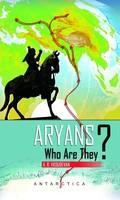
Someone who actually got published commenting on me little blog. I’m almost as happy as the time Answers in Genesis said I was wrong
But just what is the Kumari model, and should we be paying any attention to Vasudevan and his book and blog comments?
The Kumari Model of human origins claims that humans didn’t evolve in Africa, but rather, they originated on a continent in the Indian Ocean known as Kumari land, which was swallowed by the sea ~14,000 years ago. This Atlantian-esque region was huge, connecting India to Africa and extending southwards into the Antarctic. As humans migrated out of Kumari land and populated the rest of the world they took two routes, one West into Africa and East into India. Those moving into India continued migrating northwards, eventually settling Europe and the rest of Asia too.
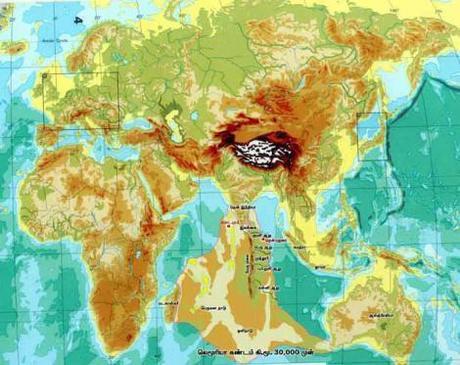
The lost continent of Kumari land: home of humanity?
Vasudevan claims there’s a lot of evidence in favour of this Indian origin of Europeans, in turn lending credence for the Kumari model. Most of it comes from the Genographic Project: an effort by National Geographic to trace how genes have moved around the world. This has led to discoveries which provide evidence for the Kumari model like:
- The discovery Europeans are more closely related to Indians than Africans (because they were part of the same migration out of Kumari land)
- The genographic project revealing that the European migration began in India
- The fact that humans split into two groups for almost a hundred thousand years (as they migrated in separate directions out of Kumari land)
These claims certainly makes a compelling case for the Kumari model. But before you go searching the Indian Ocean for the real cradle of humanity, it’s worth pointing out that these aren’t actually the findings of the genographic project.
For example, Vasudevan claims that the genographic project has discovered that the migration into Europe originated from India, not Africa, and have redrawn their map of human migration accordingly.
The Geographic Project . . . stated “. . .[genetic evidence] supports a southern route of migration from Bab-el-Mandab strait in Arabia before any movement heading north. . .”. Accordingly they have redrawn the map of migration where migration of Eurasians starts from South India. . . This makes the Eurasian migration shown in the book [Aryans: Who are they?] gain scientific acceptance.
However, if you go to the Genographic website you’ll find they haven’t redrawn the map to show Europeans originating in India. This is because the southern migration through Arabia they’re referring to is not the same migration that gave rise to Europeans. Rather, there was a group of humans who followed the coast from the Middle East, around India and down into Indonesia and Australia. Thus Southern India did play a special role in human migration, but it was in the movement into Australia, not into Europe.
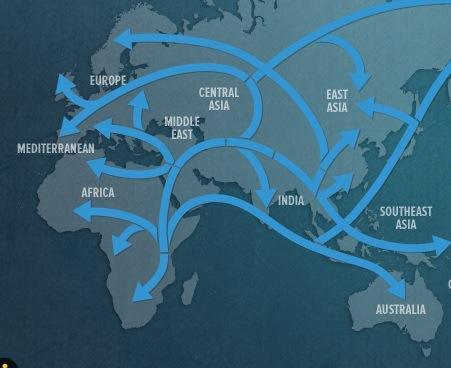
The map based on the Genographic data. The discovery they’re talking about is the bottom arrow leading to Australia. Note how it doesn’t go to Europe. Also note the lack of arrow leading from India to Europe.
Vasudevan also argues
Another finding from Genographic Project is “Ancient humans started down the path of evolving into two separate species before merging back into a single population. The two populations lived in isolation for 10,000 years”. According to the Kumari Model, the African population was a subset of the Kumari population till 60,000 years with a common genetic history. Therefore the significant finding of Genographic Project fits in perfectly with the Kumari Model
Again, he’s mis-representing the findings of the Genographic Project. They didn’t find that Europeans and Africans had been separated for ages as they migrated in different directions from Kumari land. No, the divergence they identified was between two African populations so is completely inconsistent with his little model.
In fact, the only time Vasudevan doesn’t mis-represent the Genographic project is when he talks about how Europeans are more closely related to Indians than Africans. Of course, what he doesn’t mention is that this is exactly what you’d expect to find under the mainstream model of migration out of Africa.
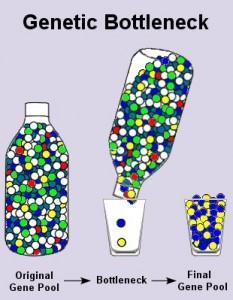
The bottleneck effect, showing how migrations lead to reduced diversity
When a small segment of a population migrates into a new area they take with them a small segment of the original populations’ genetic diversity. Any migrations that this less diverse population undertake will in turn contain this reduced diversity, and thus be more similar to the first migration than the original population. In other words, we’d expect those who branched off from the migration out of Africa to be more similar to each other than too the original African population.
So when Vasudevan provides an accurate account of the Genographic project it supports his model. In every other instance the real findings lend no credence to the idea we evolved in the mystical Kumari land. However, I don’t think the complete absence of genetic evidence is the biggest problem with the Kumari hypothesis. No, the final nail in the coffin comes from topograhic maps of the Indian Ocean.
Vasudevan claims that 14,000 years or so ago sea levels were 130 metres lower, which is why the Kumari continent was above sea level. However, if you look at maps of the Indian Ocean it becomes readily apparent that to have anything as big as Kumari the sea would actually have to have been 3,000 metres lower. It’s not been that low in millions of years, and certainly wouldn’t have been so when humans were allegedly evolving there.
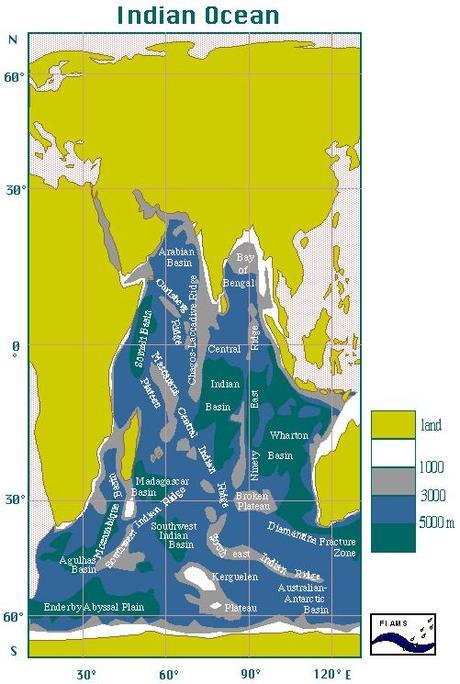
Without any genetic evidence indicating there was a migration out of Kumari, and no geographical evidence there even was a Kumari, I feel pretty confident in labelling Vasudevan’s model “dead wrong.”

